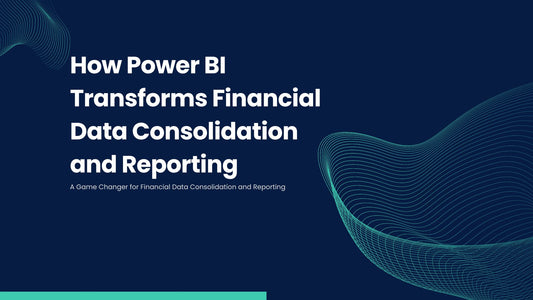Power BI vs Fabric
With the recent announcement of Microsoft Fabric, one of the questions we keep being asked is: Does Fabric replace my PowerBI ecosystem? The simple answer is: No, Microsoft Fabric does not replace your PowerBI deployment, it enhances it. PowerBI simply becomes one of the multiple tools now included in Microsoft Fabric. What you have built in PowerBI is not lost; on the contrary, Fabric now allows you to consolidate even more of your data and analytics needs under one roof.
Business intelligence has become essential for modern enterprises, and choosing the right data analytics platform is crucial. With Fabric, Microsoft leverages its impressive number of PowerBI subscribers on the visualization side to capture even larger market share in the data acquisition space currently dominated by Snowflake, Google Query, AWS RedShift, SAP Datasphere, and others. Your investment in PowerBI is not threatened, as this architectural change actually enables you to better meet your data acquisition needs without leaving the Microsoft ecosystem. It is actually the providers we just mentioned who should be concerned...
If you are currently using one of these providers and wondering what Fabric could do better for you, here are 5 unique advantages of Microsoft's new ecosystem that make Fabric a compelling element to consider in your next architecture review. Few people realize that this change puts Microsoft Fabric as likely the best option in terms of BI strategy for most businesses in the months and years to come.
Advantage 1: Seamless integration with the Microsoft ecosystem
One of the main advantages of Microsoft Fabric lies in its seamless integration with the Microsoft ecosystem. If your company already uses Microsoft technologies such as Azure, SQL Server, PowerBI, or Office 365, Microsoft Fabric offers a cohesive experience and facilitates data interoperability. You can leverage your existing investments and benefit from smooth integration between different platforms, allowing you to access data faster and improve operational efficiency. The same data is stored only once but can be used by multiple communities according to their needs (business analysts, data scientists, data engineers, BI developers, etc.). Data loaded through any of the Microsoft Fabric tools is visible to all other components of Fabric thanks to the famous OneLake, which Microsoft defines as the equivalent of OneDrive but for data.
Additionally, Microsoft Fabric supports a variety of programming languages such as SQL, Python, and Spark, providing additional flexibility for developers and data analysts who prefer working with familiar tools.
Advantage 2: Scalability and exceptional performance
Microsoft Fabric is designed to handle large volumes of data and offers exceptional scalability. Whether you need to process lightweight workloads or complex queries on a large scale, Microsoft Fabric can adapt to your needs. With the integration of Apache Spark technology, Microsoft Fabric offers high performance and efficient task parallelization, resulting in faster results. This makes it an ideal choice for companies that require real-time analysis or massively parallel processing capabilities.
Advantage 3: Enhanced security and compliance
Data security is a major concern for any business. Microsoft Fabric offers advanced security features to protect your sensitive data. It provides data encryption at rest and in transit, multi-factor authentication, role-based access management, and advanced threat monitoring.
Moreover, Microsoft Fabric is compliant with a wide range of security and compliance standards, including GDPR, HIPAA, and ISO 27001. This enhanced compliance allows you to meet regulatory requirements and ensure the confidentiality, integrity, and availability of your data.
Advantage 4: Built-in AI and ML capabilities
Microsoft Fabric includes built-in artificial intelligence (AI) and machine learning (ML) capabilities, allowing you to unlock the full potential of your data. You can create and deploy AI/ML models directly within Microsoft Fabric, without the need to transfer data to another platform. This simplifies the development and operation process of models, while reducing costs and complexities associated with managing multiple environments.
Advantage 5: Strong ecosystem and community support
Microsoft Fabric benefits from a strong ecosystem and community support, which can be a major asset for your business. Microsoft has a cloud platform that is now a market leader, with wide adoption by many companies worldwide. This means there is a vast community of users, developers, and IT professionals who can share their knowledge, best practices, and tips to maximize the use of Microsoft Fabric.
Official Microsoft documentation, community forums, technical blogs, and online tutorials provide a wealth of information to help you troubleshoot issues, discover new features, and obtain practical advice. Additionally, Microsoft offers comprehensive technical support for Microsoft Fabric, allowing you to receive assistance when needed and benefit from regular updates and platform improvements.
Furthermore, the popularity of Microsoft Fabric means that there is a wide range of training resources available, from free online courses to official certification programs. This facilitates skill acquisition for your team and allows you to maximize the use of the platform.
Conclusion
Microsoft Fabric now offers a comprehensive and powerful solution for business intelligence, from data acquisition to visualization, with a range of features and close compatibility with the Microsoft ecosystem, making it a solid choice for companies looking to fully leverage the potential of their data. The key takeaway is that Fabric does not replace PowerBI, it enhances it!
The remaining question to clarify is how much it will cost. Nobody can claim to know the answer for now, as Fabric can currently be activated for a 60-day free trial to test its various features. One thing is certain, Microsoft will have an advantage in modulating a cost that will encourage current Synapse customers (or those on other platforms) to make the leap. We will keep you informed when the time comes. In the meantime, we have several other pieces of information to share about each of the new components in the coming weeks.
If you need more specific information, feel free to contact us, and one of our team members will be happy to guide you through all the innovations brought by this significant architectural change.




